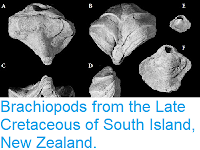The Hyoliths are an enigmatic group of shelled invertebrates known from the Earliest Cambrian until the End Permian Extinction. They had conical shells with opercula (lids), and sometimes a pair of curved horns called 'helens'. The exact nature of Hyoliths was for a long time considered a mystery, with most palaeontologists considering them to be either a form of Mollusc or an extinct phylum of animals of unknown affinities. However, recent studies of Hyoliths with preserved soft tissues and shell microstrucure has led to the conclusion that they were lophophorate animals closely related to Brachiopods.
In a paper published in the European Journal of Taxonomy on 24 January 2019, Martin Valent of the Palaeontological Department at the National Museum in Prague, Oldřich Fatka of the Institute of Geology and Palaeontology at Charles University, and the late Ladislav Marek of the Institute of Geology of the Czech Academy of Sciences (Ladislav Marek died in 1995, but is included as a co-author by Valent and Fatka because he began work on the paper before he died), describe a new species of Hyolith from the Middle Cambrian Buchava Formation of the Skryje-Týřovice Basin in the Barrandian area of the Czech Republic.
The new species is named Alfaites romeo, where 'Alfaites' derives from the Greek letter alpha (Α), which the species resembles, and 'romeo' refers to the character Romeo Montague from Shakespeare's play Romeo and Juliet; Marek originally planned to slit the specimens assigned to the genus into two species, Alfaites romeo and Alfaites juliet, but Valent and Fatka could find no justification for this analysis. The species is described from seven specimens collected by Ladislav Marek and Petr Šlehofer in the 1970s and 1980s. These have almost flat sided shells with rounded lateral edges.
Alfaites romeo. (A)-(B) Holotype (NM L46640). (A) Outer mould of internal side of operculum. (B) Detail of outer mould of internal side of operculum with marked cardinal teeth. (C)–(I) Paratypes. (C) Outer mould of internal side of operculum (NM L46642). (D) Outer mould of external side of operculum (NM L46646). (E) Outer mould of external side of operculum (NM L46641). (F) Outer mould of apertural part of conch – lateral view (NM L46645). (G) Inner mould of apertural part of conch – dorsal view (NM L46645). (H) Subtrigonal cross-section of conch (NM L46643). (I) Outer mould of dorsal side of conch with distinct asymmetrical ribs (NM L46644). Scale bar is 1 mm. Valent et al. (2019).
See also...
Follow Sciency Thoughts on Facebook.







